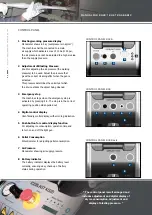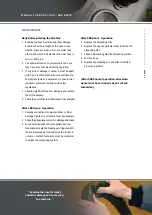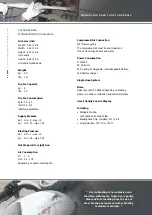
MANUAL for kg20 kg6 kg6 bAsic
dr
y
ic
e
bl
a
sting
eq
uipm
ent
fro
m
icetech
|
P
A
ge 2
NoZZLe seLecTioN
AND Air coMsUMPTioN
Nozzle Diameter and spread Angle
Nozzle selection should be based on
finding
the best
combination of nozzle diameter and effectiveness of
blasting jet for the cleaning process concerned – the
aim being to maintain a desired and stable air velocity
from the nozzle. furthermore, the selection of nozzle
spread angle will depend on how strong or weak a
cleaning effect is desired for a given dry ice
consumption. a small spread angle gives a con-
centrated jet with a high cleaning effect on a small
surface and thus a comparatively slow
workflow.
a large spread angle results in a jet which for the
same consumption of dry ice cleans a larger sur-
face with a lesser cleaning effect, but gives a faster
workflow.
initially, it is most important to select the size of
nozzle which will provide the desired air velocity using
the available compressor capacity. the subsequent
choice involves optimising the combination of cleaning
effect, dry ice consumption and the time required for
the cleaning process itself. refer to the table below to
see the relationship between air consumption, size of
nozzle and the desired pressure in the nozzle
(~ velocity of the dry ice pellets) for guidance on
possible combinations.
Air consumption Table
the marked areas in the table indicate the combi-
nations used for most cleaning tasks.
however, a blasting pressure of up to 16 bar/232 psi
for Kg50 and Kg30 (10 bar/145 psi for Kg12) can
be used. these are the maximum supply pressures
of the machine and should only be used if the task
demands maximum air velocity.
example of Use of the Table
if the desired cleaning effect suggests a blasting pres-
sure of 7 bar/102 psi, and the available compressed
air supply is 5 m
3
/min (176 ft
3
/min) at this pressure,
the table will indicate a size 8 nozzle.
this uses 4.8 m
3
/min (169 ft
3
/min) while a size
9 nozzle using the same pressure has a consumption
of 6.1 m
3
/min (215 ft
3
/min), which is higher than the
available quantity of air.
if, on the other hand, with the quantity of air
available a somewhat higher cleaning effect (nozzle
velocity) is desired, the table will show that it can be
achieved using a size 7 nozzle.
this will increase the blasting pressure to 8 bar/
116 psi without exceeding the available capacity,
i.e. 8 bar/116 psi will use 4.1 m
3
/min (145 ft
3
/min),
a
figure
not
exceeding
the available 5 m
3
/min
(176 ft
3
/min).
“ environmentally friendly
Dry ice blasting is completely non-toxic and
no hazardous chemicals are used.
costs connected with the disposal of blasting
media, chemicals or solvents are saved. ”





































